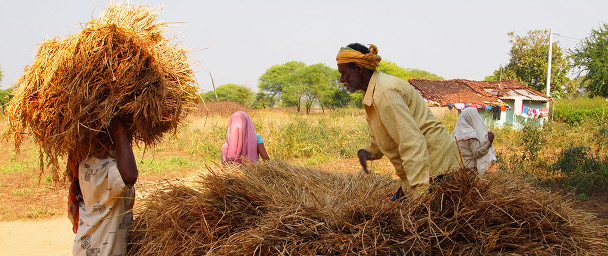
With Halloween behind us and harvest season coming to an end, the dormant months begin for many agricultural workers around the world. After planting, sowing and nurturing their crop, farmers see the harvest months as a measure of their productivity -- and hopefully -- a time of prosperity.
For those of us who aren’t directly involved in agriculture, fall is often seen as a time for celebration with family, although many of those celebrations are in fact tied to the harvest season. For example, Rome’s holiday, Cerelia, celebrates the bountiful harvest with the goddess of corn: Ceres. In Korean culture, harvest celebrations take place during Ch’usok, in which families feast and make pilgrimages to visit ancestors and family members’ graves. And in Ghana, the Homowo festival honors the recent yam harvest with a feast of food, dancing and fun.
For many reasons beyond these cultural traditions, farmers continue to play a pivotal role in communities around the world; roughly 2.5 billion people in less-developed countries derive their livelihoods from agriculture.
Studies by the Food and Agriculture Organization also paint an elaborate picture of the changing demands on agricultural production. In less-developed countries, declining mortality rates, prolonged life expectancy and high fertility rates signal population growth that’s likely continue through the 21st century. Rural settlements are also transforming into urban areas more frequently, which can have profound effects on food access. But even with these shifting demands on agriculture, one thing that hasn’t changed is its influence on economic growth.
Studies by the Food and Agriculture Organization also paint an elaborate picture of the changing demands on agricultural production. In less-developed countries, declining mortality rates, prolonged life expectancy and high fertility rates signal population growth that’s likely continue through the 21st century. Rural settlements are also transforming into urban areas more frequently, which can have profound effects on food access. But even with these shifting demands on agriculture, one thing that hasn’t changed is its influence on economic growth.
While the industrial revolution was widely viewed as a catalyst in economic and population growth, agriculture is now largely regarded as the true precursor to the rise of industry and services. According to the World Bank, agriculture can be 3.2 times more effective at reducing $1/day poverty than growth in other sectors. And with so many rural areas dependent upon agriculture today, there’s a unique opportunity to address poverty and economic development by supplementing the investments needed for growth.
No matter how you plan to spend this season, we hope you’ll take time to celebrate the amazing people who strive to create transformative change in their communities. Whether it’s a farmer, agricultural worker or cattle rancher, Kivans have the opportunity to support the world’s largest workforce. Your investments can promote economic growth and financial independence for both individuals and communities, allowing them to ultimately expand their businesses and supply food to an even greater network of people.
Search for agricultural loans on Kiva today!
Search for agricultural loans on Kiva today!
PREVIOUS ARTICLE
Frankfurt, Germany – A Day in the Life of a Kiva Fellow →NEXT ARTICLE
Introducing the Kiva Zip Trustee Advisory Board of Kenya! →














